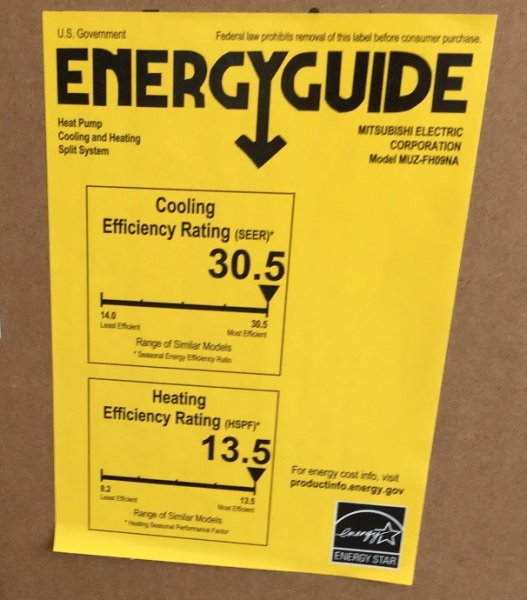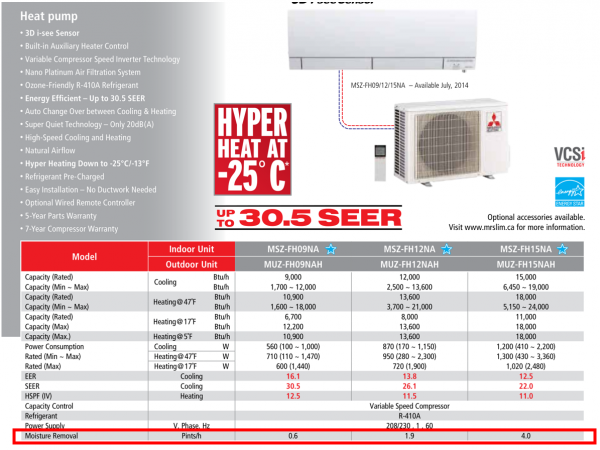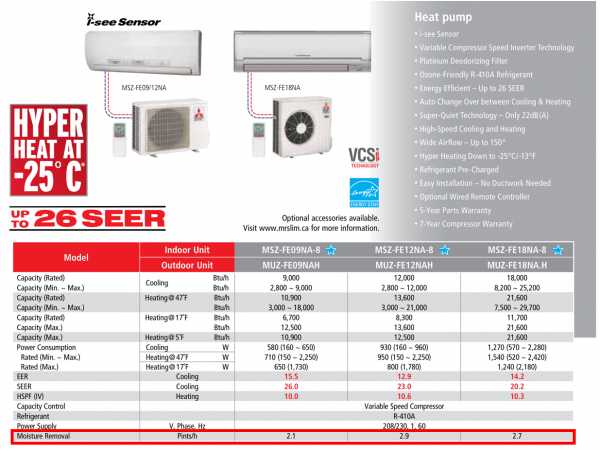“Yellow tags” have motivated appliance and comfort conditioning manufacturers to continuously improve the performance of their products. Similar to “mpg” stickers on cars, yellow tags push manufacturers to keep up with the competition. Air conditioning manufacturers complained to US DOE (Department of Energy) for years that a SEER value of 20 was not economically attainable. When someone broke the SEER 20 sound barrier, and the race was on! Not only was SEER 20 reached, but SEER 30+ values are now being marketed (the yellow tag photo above is for a ductless minisplit heat pump we installed a few years ago).
The problem with yellow tags and other performance tests, is that they neglect important factors encountered in actual operation. It is great that they motivate companies toward higher performance using some type of well-defined, standard test, but they cause real problems when the test does not reflect real world operation.
Our June 2019 newsletter article on crankcase heaters (Watch Out for Cranky Heaters! ) described the impact of crankcase heaters on heat pump performance. A crankcase heater “protects” the compressor in heat pumps during cold weather (note: properly designed heat pumps, such as the CERV and CERV2 units, do not need crankcase heater protection), but ironically, crankcase heaters are prone to failure, which then leads to compressor failure in systems that rely on them for cold temperature operation. Why aren’t crankcase heaters part of the yellow tag test procedure? Industry lobbyists can answer that question.
According to the Association for Energy Affordability (AEA) report on multi-family electrification projects, crankcase heater electrical power prevented the Atascadero multi-family project from reaching its intended net-zero operation goal. Unknown to the project’s designers (and difficult to find in heat pump and air conditioning spec sheets and submittals), their selected heat pump unit kept crankcase heaters active for most of the year!
In this article, we point out another yellow tag problem. The drive to improve SEER values for cooling operation has resulted in an increase of “sensible” cooling at the expense of “latent” (dehumidification) capacity. SEER ratings do not include moisture removal, which may not be so important in Yuma, but certainly is important from Houston to Key West as well most of North America at some time of the year.
Two submittal sheets shown below illustrate this effect for Mitsubishi’s popular ductless minisplit units. The yellow tag photo is for the newer 9000 Btu/h unit which has a spectacular 30.5 SEER value. The older generation unit was “only” a 26 SEER.
Look closer at the moisture removal line on the two specification sheets. The newer 9000Btu/h unit lists only 0.6 pints per hour in comparison to the older unit’s 2.1 pint per hour moisture removal capacity! Similarly, the updated 12,000 Btu/h unit dropped from 2.9 pints per hour to 1.9 pints per hour of moisture removal capacity.
Note that the older 2014 submittal sheet shows 2.7 pints per hour for an 18,000 Btu/h minisplit unit with a SEER value of 20.2 while the updated unit has been changed to 15,000 Btu/h nominal capacity with SEER value of 22 and an increased latent capacity of 4 pints per hour! What happened? We don’t know for sure, but here is our guess. The “new” 15,000 Btu/h unit is the same as the old 18,000 Btu/h unit, just derated to a nominal 15,000 Btu/h capacity. How does one derate a heat pump? Slow the compressor. This reduces capacity which has a favorable effect of increasing both SEER and moisture removal capacity. To learn more about trends and characteristics of minisplit heat pumps, read our news article, “Minisplit Mania” and accompanying report.
Heat pump engineers know they can gain “sensible” cooling capacity at the expense of “latent” capacity in a few manners, with the desired result of increasing their SEER value. What do they do? They increase air flow rates, slow compressor speed, and add indoor unit heat exchanger surface area. These actions increase the temperature of the indoor heat exchanger closer to the room air “dew point” temperature, the temperature at which water in the air will condense on the heat exchanger. The overall impact is an increase of SEER value at the expense of moisture removal.
Ironically, today’s highly insulated and highly sealed homes need more latent capacity, not less! Most regions of North America require a dehumidifier to make up for today’s lack of latent conditioning capacity and increased indoor humidity. The good news is that dehumidifiers convert “latent heat” into “sensible heat” which brings the AC unit back into play. Also, dehumidifiers provide moisture removal capacity during swing seasons when no cooling is desired.
Want to learn more about moisture management? Read our 4-part report series on Handling Humidity! Warning: several cups of coffee required!


























